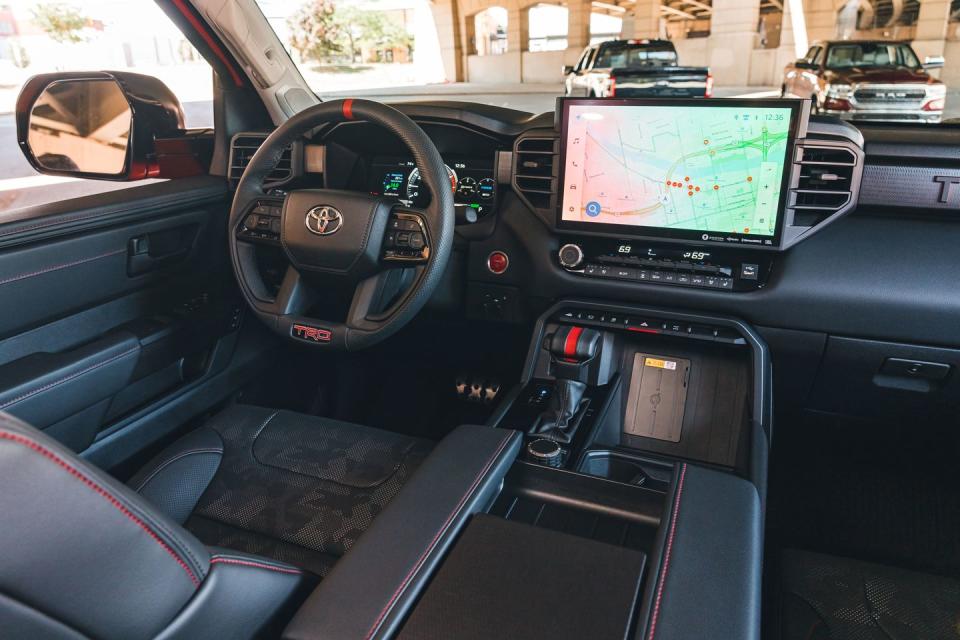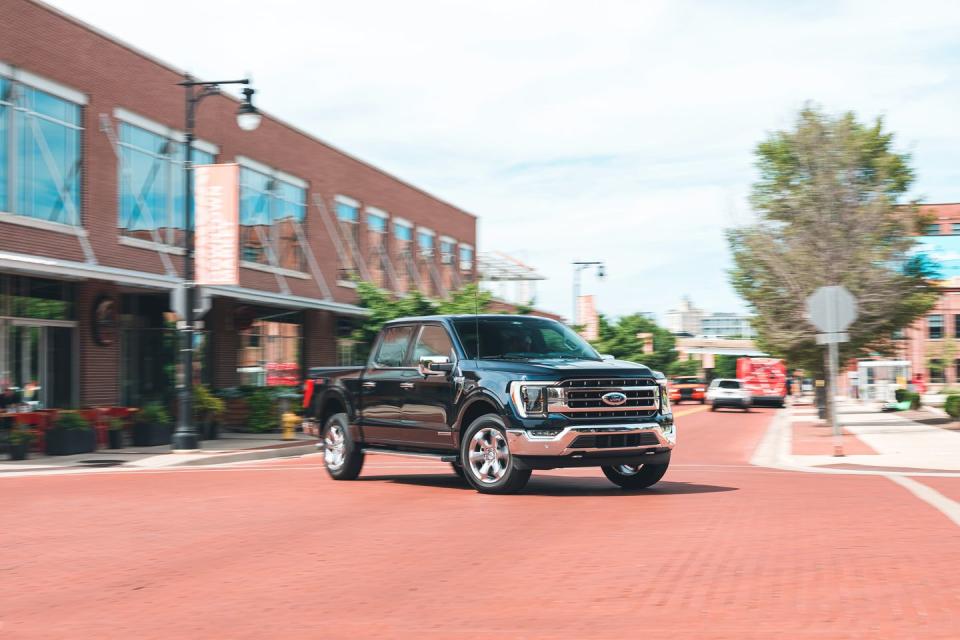Comparison Test: 2021 Ford F-150 PowerBoost vs. 2022 Ram 1500 vs. 2022 Toyota Tundra TRD Pro

From the October 2022 issue of Car and Driver.
Around here we like nothing better than to lean against a dusty wall, squint into the middle distance, and grumble short declarative sentences about pickup trucks. "Some new trucks out," one of us might say, while spitting casually on the ground. "Sure are," one or the other grizzled car wranglers would grumble, punctuating the idea by idly kicking away a scorpion. "Some of 'em even electrified, I reckon." And then, after a minute or two of quiet self-reflection of our regrets, a third tester might say, "We should round up a Toyota Tundra TRD Pro, a Ford F-150 Lariat PowerBoost, and a Ram 1500 Limited eTorque and conduct a rigorous and thorough comparison test of hybridized full-size pickup trucks." That's about the time the office manager comes in and tells everyone to go outside, please. Enough with the dust and the spitting and the scorpions! Do we have to do this whole thing every time we plan a truck comparison? Honestly.
Hey, we like to get in the proper mindset, even when the trucks in question are partially propelled by this newfangled "electricity." And all three of these bruisers have some form of battery-electric assist bolstering their internal-combustion powerplant. The Tundra augments its 389-hp twin-turbo V-6 with an electric motor that chips in 48 horsepower and 184 pound-feet of torque. The F-150 uses a 400-hp twin-turbo V-6 paired with an electric motor that makes 47 horsepower and 221 pound-feet. A 16-hp motor that twists out 130 pound-feet of torque joins the Ram's 395-hp V-8. The Ford and the Toyota can roll down the road on electric power alone, while the Ram's setup is more for torque fill-in and smooth starts. But they all have an engine and a motor, so here we are.
This trio reminds us of the joke where a Tundra TRD Pro, an F-150 Lariat, and a Ram 1500 Limited all walk into a bar, and then a month later we get letters complaining that those trims don't align. Well excuse us, but maybe you've heard about supply-chain issues? Yeah, that applies here too. And anyway, they're all priced around $70,000, and we doubt matchy-matchy trims would've changed the results any, so feel free to mail those letters to 123 Go Away Street, care of Cut Us Some Slack.
Okay, now that the parameters are clear, let's talk trucks.
3rd Place:
2022 Toyota Tundra TRD Pro

Highs: Major torque, cushy Fox suspension, airy cabin.
Lows: No full-time all-wheel-drive mode, hybrid battery kills interior storage, weight negates power advantage.
Verdict: One for the Tundra fans.
The new Tundra is a quixotic beast. You get the idea that along many points of the product-development decision process, Toyota said, "We're not going to outsell any of the domestic trucks no matter what we do, so let's not strain ourselves." And thus the hybrid system uses a nickel-metal hydride battery instead of a lithium-ion one, and it takes up all the rear under-seat storage. The transfer case doesn't have a full-time mode, meaning that in normal on-road driving the TRD Pro is rear-wheel drive funneling 583 pound-feet to an open diff beneath an unladen pickup bed—in the rain, a hybrid Tundra might do a one-wheel peel until it runs out of gas. Which, incidentally, it drank at the highest rate of our trio, averaging 16 mpg in our testing. That provided us frequent opportunities to notice that the Tundra still has a gas cap, while the other trucks have capless fillers.

The Tundra is nice to drive, the coil-spring rear end feeling composed and the Fox internal-bypass dampers (with remote reservoirs at the rear) helping to smother lumpy pavement. The 437-hp hybrid powertrain delivers easy muscle, with the synthetic V-8 soundtrack combining with the real turbocharger intake hiss to make it sound like you're driving a Mercedes-AMG GT (from inside the cabin, anyway). But that best-in-test horsepower and torque didn't correspond to the quickest acceleration, in part because the Tundra, at 6174 pounds, was also the heaviest truck here. Its 5.9-second 60-mph time lagged behind the F-150's sprint by 0.6 second, and its 14.5-second quarter-mile at 95 mph exactly matches the run we recorded from a nonhybrid Tundra Limited. The hybrid does earn a 1- to 2-mpg EPA combined fuel-economy advantage against its conventionally powered counterpart, so there's that.
Certain facets of the TRD Pro interior aren't directly comparable to the other trucks—camo-look SofTex upholstery is its own lifestyle choice—but we can make some observations that apply to any Tundra trim. For instance, the available panoramic roof and roll-down rear window give the Tundra the airiest pickup cabin this side of a ragtop Jeep Gladiator. However, neither the 8.0-inch standard center display nor the optional 14.0-inch screen includes a tuning knob, and a fat driveshaft hump bisects the rear floor. Why design a new truck with a driveshaft hump? The Ram and the Ford have flat floors.

The previous-generation Tundra, introduced in 2007, was a striver, overengineered compared to its contemporaries. And yet it still never outsold any of the domestic trucks, a fact that likely informed the product planning on this latest one. As one logbook entry put it, "This truck makes me think Toyota has given up on chasing the Detroit Three and is instead focused on pleasing its loyalists." It's not a bad truck, the Tundra. But it doesn't exist in a vacuum.
2nd Place:
2021 Ford F-150 Lariat PowerBoost 4x4

Highs: Quite quick and most efficient, onboard generator, hands-free cruise control.
Lows: Shivering structure, leaf-spring rear end, petrochemical-based interior.
Verdict: A truck that straddles the future and the past.
The F-150 PowerBoost almost feels like a retro-rod. Here we have a hybrid powertrain that puts out 430 horsepower and 570 pound-feet of torque, an aluminum body, hands-free highway driving via Ford's BlueCruise system, and generator functionality that turns the truck into a portable power station. But when you're bounding and clomping down a rutted back road, and that leaf-spring rear suspension is dancing with a ditch—just like it would have on your pappy's truck way back when—the F-150 doesn't come across as a showcase for innovation. This seems like a traditional pickup that learned some cool tricks rather than some fully realized expression of pickup modernity. "The truck that's the quickest with the least amount of body control—it's an exciting combination," read one logbook note.

The hybridized F-150 does put up some great numbers. There's the best-in-test 5.3-second 60-mph time and 13.8-second quarter-mile at 101 mph. And it also earned the best observed fuel economy (18 mpg), had the quietest cabin at 70 mph (64 decibels), and notched the highest payload and tow ratings. So why isn't this the winner?

 Yahoo Autos
Yahoo Autos 